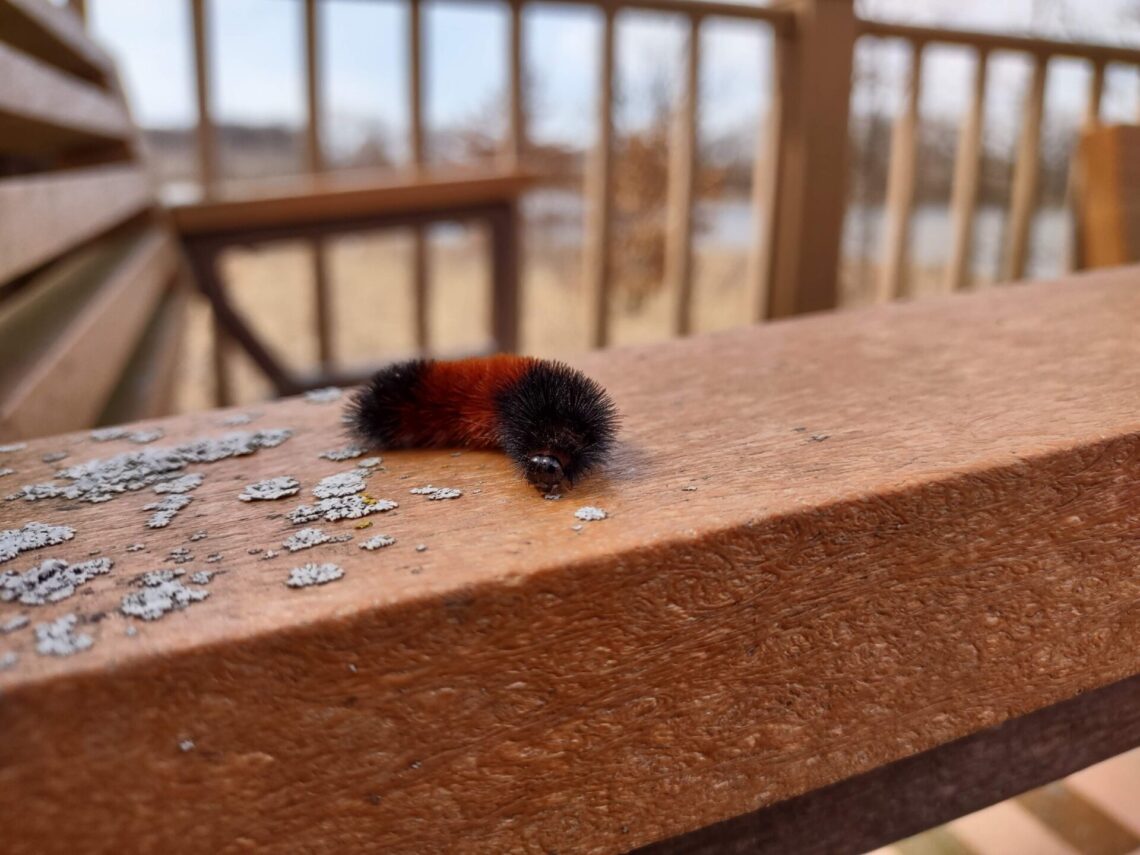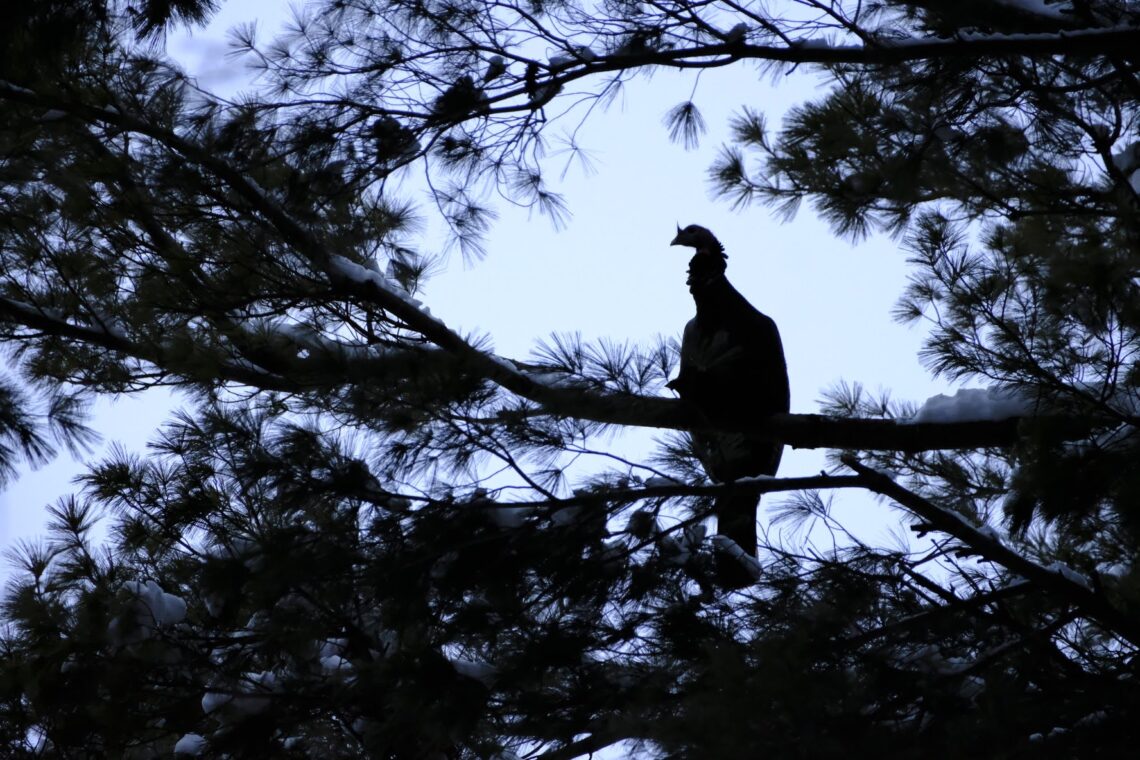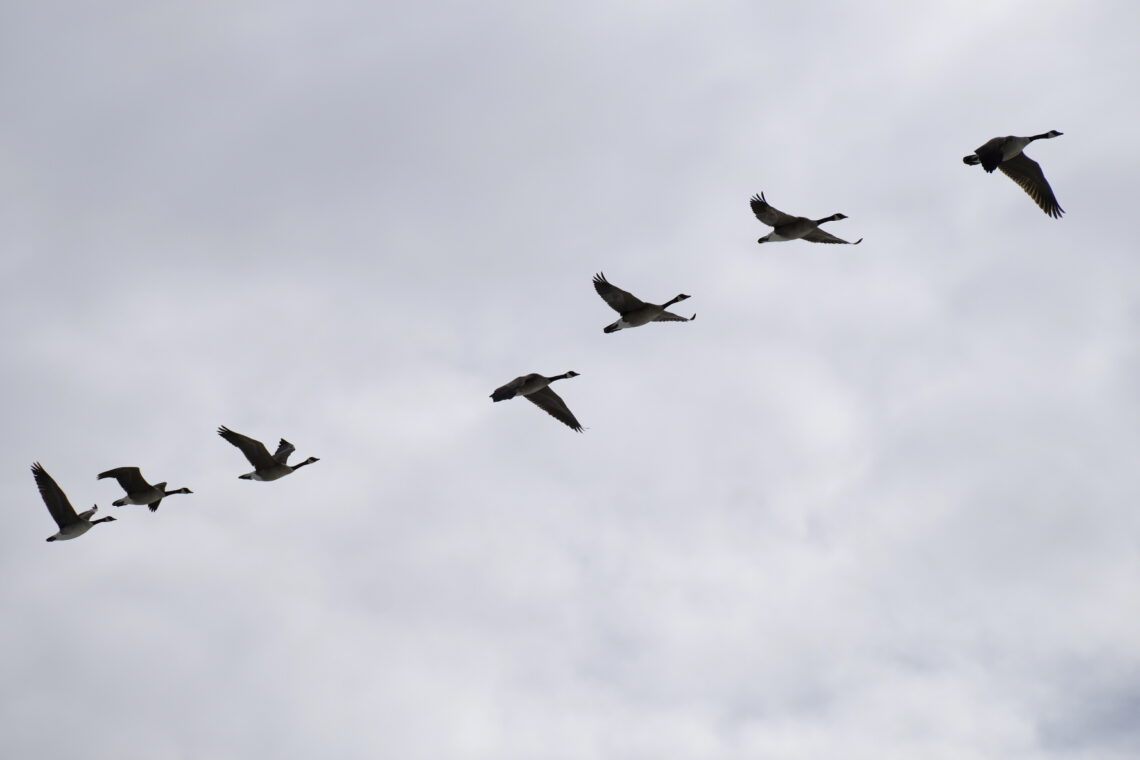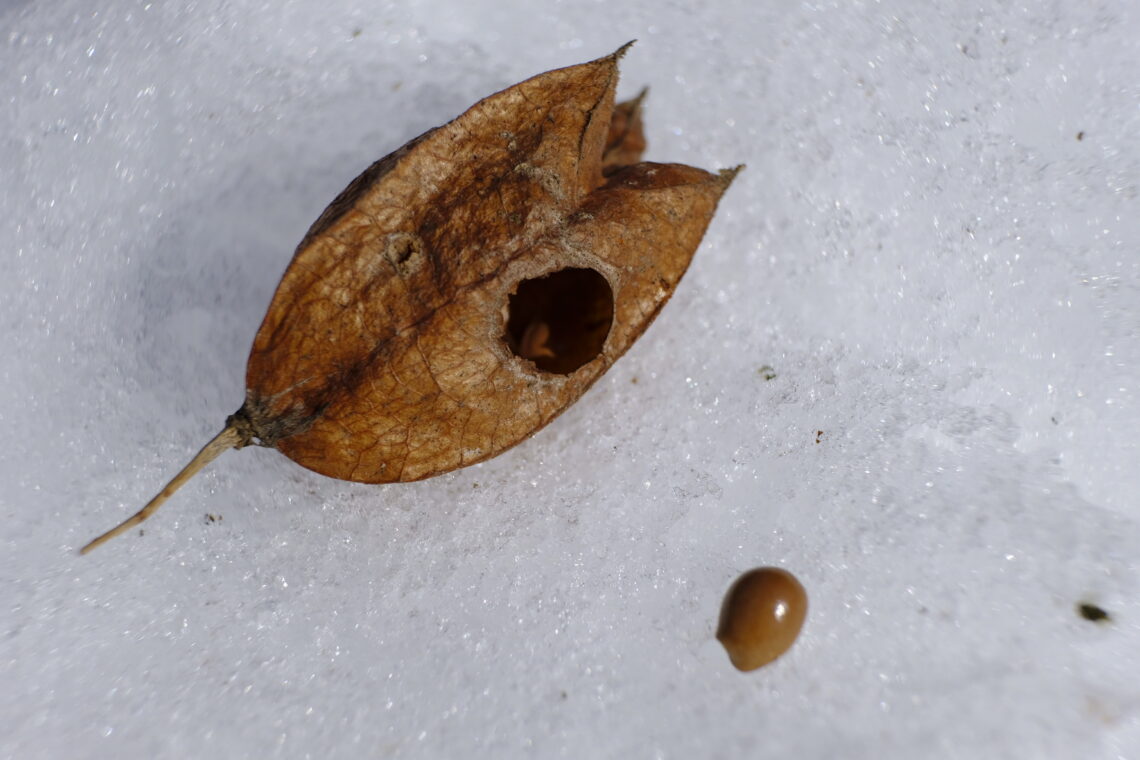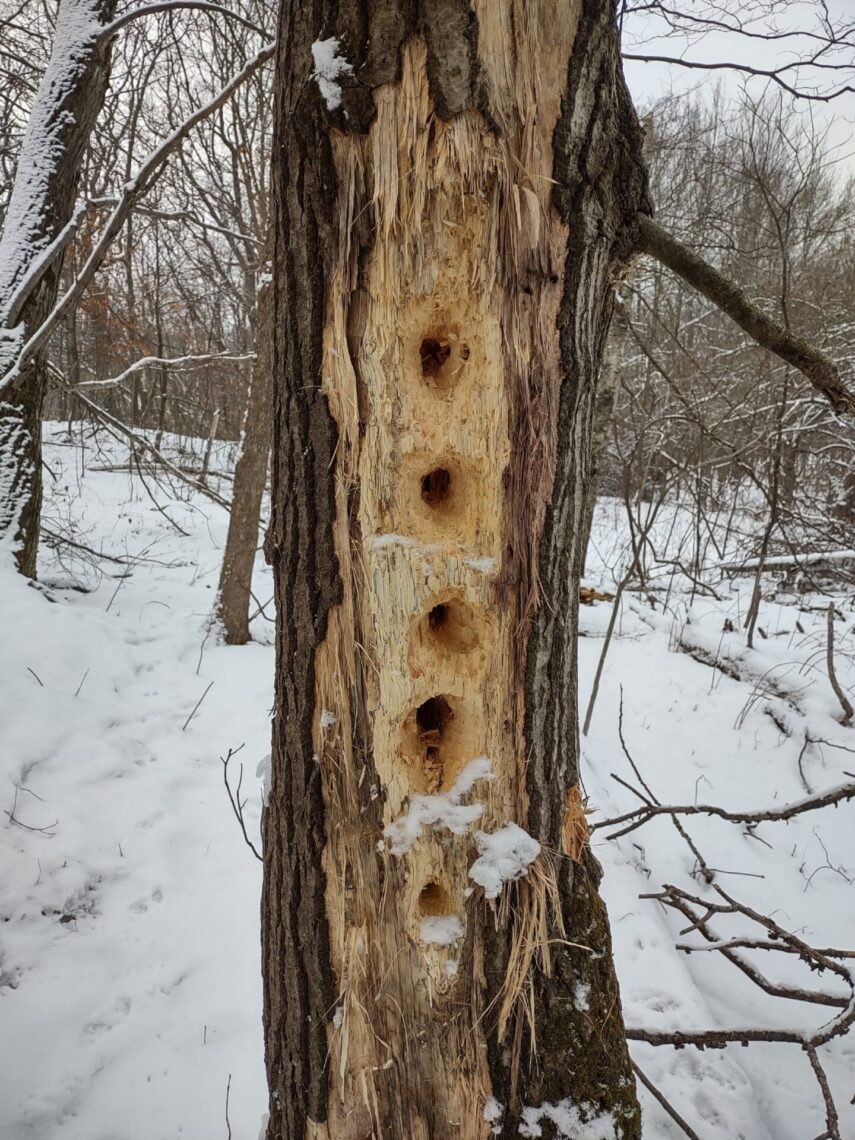Spring is finally here! It didn’t seem like it would ever actually happen, but here we are. The birds are singing, the chorus frogs are chirping, and plants are starting to emerge from the soil. It’s a great time of year for many reasons, but I especially like it because it seems so much easier to notice the little changes in nature. While you’re here, let’s take a quick virtual tour of some of those changes that are happening right now!
Woolly bears are back! Well, I guess they never really went anywhere to begin with, but now they’re active. Did you know that wooly bear caterpillars produce a chemical in their body similar to anti-freeze which allows them to almost freeze completely solid over the winter? Once the temperatures begin to warm up, these fuzzy little caterpillars thaw out and become active (and very hungry). After a few days of eating, they build a cocoon and eventually emerge as an Isabella tiger moth!
While out on a hike with my family, we went to a local green space in search of woodcock. This time of year is when they typically do their sky dance and can be heard ‘peenting‘ at dusk. We were lucky enough to both hear and see this wonderful springtime display from such an odd bird.
As we continued our hike, we headed towards a group of pines where we have seen roosting turkeys in the past. Sure enough, after briefly scanning the tops of the trees we saw four of them sitting motionless on some limbs. Even though I have known for many years that turkeys sleep in trees, it’s still one of the strangest sights to see and it always brings me joy.
If you have been out to some wetter areas lately, you may have noticed that the willows are looking quite a bit fluffier than they did a month or two ago. From a distance, the stems all look as if they’ve been lightly touched by snow, but upon closer inspection, you’ll see that the buds are actually preparing to flower. Since these willows are some of the first to bloom, the light-colored fuzz helps protect the flower buds from the cool spring air.
On this particular branch, I found what looked like a pinecone. There were actually a bunch of these all over and it turns out that these pinecone-looking structures are actually insect galls. Tiny insects called gall midges lay their eggs in the stems of willows. As a defense mechanism, the willow produces these ‘cones’ which ends up providing shelter for the insect. In the summer, these insects will emerge from the galls.
Speaking of fuzzy plants, pasque flowers are beginning to bloom! This has got to be one of my favorite flowers of all time. Similar to the pussy willow, pasque flowers are very early bloomers, as well as fuzzy. This fuzz acts as insulation against the cold weather and is very effective. In no time at all these flowers will be outstretched and soaking up the spring sunlight.
I hope you enjoyed my virtual nature tour and happy almost spring!
*Did you miss an article? Check out my collection of past monthly Nature Now articles on our website HERE. Just click the dropdown menu ‘Any Type of News’ and change to ‘Nature Now’ to filter the articles.
The Linden Cohousing Farmers Market will be back for a fourth year of bringing fresh, locally grown food to the eastside of Madison. When you shop at the Linden Cohousing Farmers Market, you are directly supporting farmers and entrepreneurs of color in our community.
The market will be held at 2082 Winnebago Street, every Thursday 3:00 – 6:00 pm, starting on May 25, 2023 and ending on September 28, 2023.
Thank you to our market sponsor TASC!
It’s almost spring! According to the calendar, we’ve got less than two weeks until winter officially ends and spring begins. There are lots of subtle (and not so subtle) clues that spring is just around the corner and I love discovering them one by one.
The temperature is starting to warm up a little, the days are lighter for longer periods of time, the birds seem to be a bit more chatty, and the tulips and daffodils have started to peak out of the ground in my yard! Note that I’m intentionally ignoring the 4-8″ of snow that’s predicted for today…
Look no further than just above your head and you’ll likely see or hear birds in migration. While it’s still a little early for most migrating birds to make their way back to Wisconsin and beyond, I’m beginning to notice more geese, sandhill cranes, and even turkey vultures flying overhead. On particularly sunny days, robins can be heard barking up a storm while chickadees belt out their classic “deee-deee” call. It’s a wonderful cacophony of sounds that will only get better as the days get warmer!
If you’re out on a hike and you happen to be near a wooded slope, riverbank, or mesic woodland, you may stumble upon these odd papery seed pods that contain a few seeds that resemble popcorn kernels (they are roughly the same size as well). The seed pods are usually in a cluster and connected to a short-growing shrub.
The plant is called American bladdernut and it’s a native understory shrub in Wisconsin. The seed pods manage to hang onto the shrub well into winter and can be found rattling in the wind.
This time of year is great for watching birds of prey since there is very little foliage for them to hide in. It seems that lately I’ve seen more hawks being chased by crows than hawks chasing their own prey, and part of that is due to their inability to remain undetected by crows while hunting for sparrows and small rodents.
In fact, one of the easiest ways to spot a bird of prey is to search for a noisy group of crows (a ‘murder’ of crows). There’s a good chance that the crows aren’t simply making a ruckus for no reason. Most of the time they’re actively harassing a larger bird until it leaves the area.
I hope you enjoyed my virtual nature tour and happy almost spring!
*Did you miss an article? Check out my collection of past monthly Nature Now articles on our website HERE. Just click the dropdown menu ‘Any Type of News’ and change to ‘Nature Now’ to filter the articles.
We’ve raised $16,500 so far to buy our first tractor and mower. Only $11,000 more to go!
Groundswell continues to improve access to Westport Prairie and to restore the prairie landscape for plants and wildlife. To care for our restored prairies and to mow our new trails, we are raising funds for our first tractor (~$25,000) and pull-behind mower (~$2,500), including insurance and maintenance.
We’re planning to buy these items used, so the kind of tractor and mower will depend on what we find available on the market. Here’s an example of a tractor and mower we’re interested in purchasing.
Give today in support of a tractor and mower! You can give online (indicate in the gift notes: for tractor) or mail a check to Groundswell at 303 S. Paterson St, Suite 6, Madison, WI 53703. Indicate in the check memo: for tractor.
Please consider joining the donors below who have already generously given to our tractor campaign:
- Phyllis Davis
- Green Bay Packers Foundation
- Stan Kanter
- Cathy Schmitz
- Cathy Schmitz’s Facebook fundraiser
- Tom Wilson
- Tracy Wiklund
- Terri Beck-Engel
- Ursula Muehllehner
- Jeff Lange & Dolly Marsh
- William & Virginia Nelson
- Stefanie Moritz & Vince Jenkins
- Kelly & Linda Sweeney
- Carrie Morgan
- Lois Curtiss
- James & Susan Zerwick
The tractor and mower will be instrumental in our efforts to restore and care for Westport Prairie.
Of the original 64,000-acre Empire Prairie that historically covered much of Dane and Columbia Counties, there are only 202 acres left that are protected. This huge loss of prairie habitat has led to dwindling populations of native plants, insects, and animals.
Westport Prairie is a 227-acre wildlife area in Waunakee, WI managed by Groundswell. It is open to the public for recreation with 1.5 miles of hiking trails. It is also part of the Empire Prairie State Natural Area that preserves approximately 100 native plant species—some endangered—and many types of grassland birds. Each year, Groundswell converts more and more agricultural land to prairie at this special place for the benefit of people and the biodiversity of Dane County.
We are in year 4 of an ambitious 14-year plan to convert a total of 170 acres of land to native prairie. As we continue to plant more prairies, we need proper equipment to manage the land and ensure that the prairie habitats we’ve planted continue to thrive well into the future. Groundswell would like to purchase a tractor to help us with the long-term land management at Westport Prairie.
If you have questions about the tractor or mower, please contact BJ at bj@groundswellconservancy.
Are you looking for an easy way to support conservation where you live in 2023?
It’s fast and simple to set up automatic monthly gifts to Groundswell. Your gifts will provide reliable, ongoing support to help protect special places for everyone in our community.
“I deeply care about spending quality time and connecting with my kids through time spent in the outdoors. Groundswell helps create, protect, and give access to those places close to home.”
-Alton Multhauf (pictured above with his family), Groundswell Sustainer & Board Member
Monthly giving is:
- Convenient: Your gifts are automatic and you don’t have to worry about remembering to donate online or by mail each year.
- Secure: Groundswell’s online giving platform is secure and your payments are encrypted, so you can rest assured your credit card or bank information is safe.
- Eco-friendly: Automatic gifts don’t require envelopes, stamps, or checks, and Groundswell can send you fewer appeal mailings knowing you are already making regular contributions.
- Special: As a Groundswell Sustainer, you’ll receive exclusive emails throughout the year so you have the inside scoop on what’s happening at Groundswell.
We hope you join the community of Groundswell Sustainers by signing up online today and selecting the monthly donation type. You can change your monthly gift amount or cancel at any time by calling 608-258-9797. Thank you for caring about conservation where you live.
More people will be able to safely access the Lower Yahara River thanks to Groundswell’s purchase of 1.64 acres south of the Dunkirk Dam. This special place is adjacent to property owned by the Dunkirk Dam Lake District and to the Town’s Charlie H. Lyon Memorial Park.
Immediately after the acquisition, Groundswell transferred the parcel to the Town of Dunkirk. The Town plans to work with the Lake District to construct amenities on the property. Current plans include an ADA-accessible path, an accessible canoe & kayak put-in/take-out, and an accessible fishing pier.
There is currently no safe public access for boaters to portage the Dunkirk Dam due to turbulent water immediately below the dam. This acquisition is further south and will allow the public to use canoes and kayaks on this segment of the Yahara Chain Water Trail. An existing parking lot at the Charlie H. Lyon Memorial Park would connect with the riverside improvements by the planned footpath.
The property had been in the Hansen family since 1945, when Otto Hansen purchased it. His son, Rollin, fished from the property and cleared about an acre of the land for a vegetable garden. The current landowners are third and fourth generations. Although they were approached by a developer, the family chose to preserve the property. “We want the public to be able to enjoy this land next to the Yahara River for years to come,” said Otto’s granddaughter Judy Adler. “Public access will enhance the Town’s park lands.”
River usage in this area is expected to increase with the City of Stoughton’s new River Park for kayaks and canoes. The River Park will be upstream from the Hansen acquisition, and some boaters will no doubt continue downstream to the Dunkirk dam. “This purchase makes possible safer and accessible access to the Yahara River, while protecting the fragile shoreline,” said Laura Davis, Chair of the Dunkirk Dam Lake District. “Right now people who want to fish must access the water on brushy, steep, and sometimes muddy trails. Our plans are to construct a safe, accessible trail that leads to an accessible fishing pier and an accessible boat launch.”
Norm Monsen, Chair of the Town of Dunkirk, termed the acquisition “…a landmark day for our Township. We look forward to working with Groundswell Conservancy on other land preservation projects through our new Rural Preservation Program.”
This acquisition was possible because of the generosity of the landowners, our partnership with the Town and the Lake District, and funding provided by the Knowles-Nelson Stewardship Program and the Dane County Conservation Fund.
Well, it’s the first week of February and up until this point, it hasn’t really felt like a true Wisconsin winter. Overall, the days have been relatively warm and the snow has been seriously lacking. This week there is predicted to be above-freezing temperatures mixed with some rain (fingers crossed it changes to snow). This is a nice reminder to get outside while winter is still here and enjoy it before it’s gone!
While it may not seem like it at first glance, the forest is alive with activity this time of year! A week or so ago, I went on a hike in Madison with some friends and family in search of owls. We headed out just before sunset and in a matter of minutes we both saw and heard Great-horned owls overheard. We also watched two yearling deer walk right across the trail we were on that were less than 25 yards away.
While that was very exciting, you certainly don’t need to see wildlife to appreciate them. Sometimes, just knowing that they were there not too long ago is just as rewarding. One of my favorite activities this time of year is searching for tracks and sign of wildlife. Just the other day we found these enormous pileated woodpecker holes that were drilled in perfect line (see photo above).
Finding fresh tracks in the snow is another way of knowing that some sort of creature was here not too long ago. Although, if you have a child around the age of five, it’s possible the tracks you’re looking at were created by them. For example, my son loves drawing bird tracks in the snow along the sidewalk on our morning walk to school. They aren’t entirely convincing, but you still have to watch out.
The tracks above are from a crow that was casually walking down the sidewalk. When the tracks are this fresh, you can even see the little pads on the bottom of the bird’s feet and the nails cutting through the snow. It’s not hard to picture what this scene looked like in real time.
Speaking of bird feet, I was out the other day and stumbled upon a dead red-tailed hawk that was likely hit by a car. I felt bad for the poor bird and decided to move it from the side of the road to the edge of the woods. The last thing I’d want is for another animal to get hit by a car while trying to get to the hawk.
It was sad to see but also educational. It’s not every day that you get to see a hawk up close. It was so neat seeing the little scales on the bottom of the foot that act like sandpaper for extra grip when catching prey. It was also cool to see just how large and sharp the talons are. This was the foot of a hunter.
I hope you enjoy the rest of your month and drive safe out there!
See you next month!
*Did you miss an article? Check out my collection of past monthly Nature Now articles on our website HERE. Just click the dropdown menu ‘Any Type of News’ and change to ‘Nature Now’ to filter the articles.
Have you noticed that we’ve been using the term HMoob instead of Hmong lately? Throughout written work, the HMoob people and language have been categorized under the generic term “Hmong.” However, the HMoob people and language represent a diverse group of communities and identities. The term “HMoob” was created by community members as a more inclusive word that encompasses two main dialects, Green and White.
To be more inclusive of the different communities within the larger HMoob community, Groundswell will use the term “HMoob” in writing going forward. Even though the spelling is different, the English pronunciation is the same (muhng).
Exciting news! Groundswell’s Conservation Director, Tony Abate, is taking on a new role at Groundswell. While his job title will stay the same, his promotion means that he’ll take the lead on our land protection efforts going forward.
“I’m eager to expand our tradition of thoughtful, strategic land protection,” says Tony. “I look forward to creating equitable access to land, protecting farmland, preserving wildlife habitat, and more.”
Over the past seven years, Tony has established strong working relationships with private landowners and Groundswell’s agency and community partners. He’s done an incredible job of leading our Stewardship Committee and developing and implementing our green schoolyard initiatives and community projects at Patrick Marsh and Westport Prairie.
We’re excited about Tony stepping into the role and building on Groundswell’s 40 years of land protection success. His expertise and knowledge of conservation easements and land management will benefit us greatly as our organization grows. We couldn’t think of a better person for the job!
Groundswell Conservancy is kicking off the new year with some exciting news! After 40 years of conservation success, we’re growing, and we need your help.
We’re looking for four people with diverse backgrounds and experiences who are passionate about protecting special places forever to join our board of directors. We’re also seeking community members to serve on our various committees.
Since 1983, Groundswell Conservancy has protected hundreds of special places in South Central Wisconsin. We work to keep rich farm soils available for farming, help elementary schools in Madison create green schoolyards, manage natural areas to care for wildlife, and connect communities to the land.
We also improve access and land tenure for farmers of color and New American farmers. We work to remove barriers to equitable access to land and nature and strive, every day, to represent the communities we serve.
We’re seeking board and committee members who are:
- Passionate about nature and protecting the environment.
- Committed to expanding access to outdoor spaces for all people.
- Experienced in areas related to Groundswell’s operations, including non-profit management, land management and conservation, agricultural activities, public relations and/or marketing, budgets and investments, community relations, fundraising, human resources, legal issues, or other functional areas.
- Inclusive, engaged, and collaborative.
- Willing to devote time, energy and/or financial resources towards advancing the mission of Groundswell Conservancy.
If you’re interested in learning more, check out the full position description.
Apply today by emailing your cover letter and resume to admin@
Applications are due by February 17, 2023.

